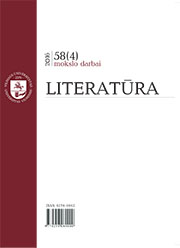Neurozės diskursas Joriso-Karlo Huysmanso romane Atvirkščiai
Discorse on Neurosis in Joris-Karl Huysmansʼ Novel À Rebours
Author(s): Vytautas BikulčiusSubject(s): French Literature, Philology
Published by: Vilniaus Universiteto Leidykla
Keywords: neurosis; discourse; naturalism; decadence; modernism; fin de siècle; dandyism;
Summary/Abstract: The study object of the paper is discourse on neurosis in novel À Rebours of French writer Joris-Karl Huysmans (1884). Although in the novel neurosis arises as an outcome of naturalism it is also a sign of idiosyncrasy and results in the formation of new perceptions of the world. The writer explains the causes of neurosis by, first of all, the genealogy of Jean Floressas Des Esseintes. On the other hand, neurosis replaces intrigue, in fact, there is not much action in the novel since focus is put on the protagonist’s inner life, reminiscences and allusions, aspirations and dreams. Although the writer depicts neurosis in detail, from genesis, to evolution, to some phases, he also shows that namely neurosis makes Des Esseintes turn to creative activity since he wants to be unique, and that wish inevitably stimulates his inclination for beauty and arts. However, the fact that there are some signs of sadism in the protagonist’s character should not be ignored. So Des Esseintes gives the order to decorate a turtle’s shell with precious stones and, although it is a very painful operation, still enjoys watching the turtle crawling in his sunlit room. Des Esseintes’ dandyism is also linked to neurosis, namely neurosis makes him admire himself like Narcissus, stay outside the mainstream, become a sensitive artist. He demonstrates his dandyish mindset by asking to make an item exclusively for him, admiring artworks the commoners are indifferent to. One more dandyish side of the protagonist’s character comes to light when he concentrates on his ego and self-creation. It should be noted that Des Esseintes, having adopted Baudelaire’s theory of “correspondence”, shows is interest in things that could evoke his senses. In the episodes of making the mouth organ and perfume, synesthesia, the situation when several sensations are evoked although a stimulus is applied to only one sensory organ, could be detected. And, finally, when Des Esseintes realizes that his disease has progressed to its final phase, music comes to his rescue. In his opinion, medieval church music and cathedral and basilica spaces form one seamless whole. When Des Esseintes’ senses are heightened by neurosis the novel starts looking like a kaleidoscope of intertwined sight, smell, hearing, visions, dreams and hallucinations. The protagonist collects senses as well as rare, exquisite goods and becomes a museum owner. His collection of small things shows that he is unable to take in reality, his world is falling to pieces. Neurosis, at first seen as a physical reaction of the human body, makes the protagonist reflect on spiritual pain and that shapes his splitting personality. In other words, decadence manifests itself when moral and aesthetic tension comes into play in the evolution of modern man.
Journal: Literatūra
- Issue Year: 58/2016
- Issue No: 4
- Page Range: 7-14
- Page Count: 8
- Language: Lithuanian

